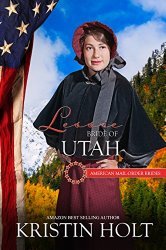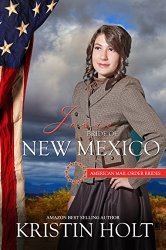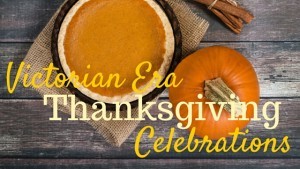Kristin Holt's Blog, page 31
February 1, 2016
Mail-Order Catalogs: Timeline and Truth
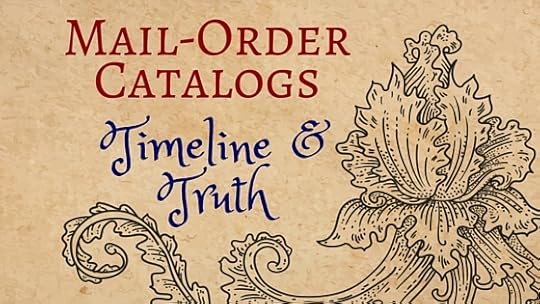

Mail-order catalogs didn’t show up in America as early as you might think… and couldn’t have impacted the mail-order bride phenomenon as early as today’s popular fiction market makes it seem.

TIMELINE:
1845: Tiffany & Co. publishes and distributes the first United States mail-order Catalog, known as the “Blue Book”. (After all, “Tiffany Blue” had to come from somewhere.)
1872: Montgomery Ward’s first mail-order catalogue debuted in 1872–a single sheet (8×12-inches) that listed more than 150 items.
1881: first known printing and distribution of the Hammacher Schlemmer catalog, selling tools and hardware.
1888: Richard Warren Sears started a business selling watches (only) through a mail order catalog.
1888: Sales from Montgomery Ward & Co. Catalogue reaches $1 million.
1894: The Sears Catalog expands to include a large variety of items.
1895: Montgomery Ward & Co. Catalogue had grown to 600+ pages.
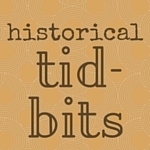 [1963: (Yes…1963) J.C. Penney had been in the retail business since 1905 when he opened his first retail store in Kemmerer, WY, expanded his stores, and finally mailed his first mail-order catalogue in 1963.]
[1963: (Yes…1963) J.C. Penney had been in the retail business since 1905 when he opened his first retail store in Kemmerer, WY, expanded his stores, and finally mailed his first mail-order catalogue in 1963.]
That’s it. The sum total of United States-based mail-order companies in the 19th Century.
If we consider North America in whole, we need to add one more:
1884: The first Eaton’s catalogue was a 34-page booklet (Toronto, Ontario, Canada).
A Wikipedia timeline of mail-order catalogs shows the vast majority began in the 20th century (1905 to 1992) and most were outside the United States.
So–why the correlation (at least in today’s fiction) of “mail-order” and lonely men in the west seeking brides from the eastern and southern states?

Q: More specifically, why aren’t Mail-Order Brides accurately refereed to as Newspaper Brides” or “Letter Brides”?
A: An oddity of the development of the English Language. Just like the “Old West” became much more popular after the frontier had been swallowed up by settlement, the phenomena of “Mail-Order Brides” became more curious.
By then “Mail-Order” was a household term. Catalog purchases of nearly everything was a standard procedure for farmers and ranchers living in isolated areas. According to most historians, the term “Mail-Order Bride (or Mail Order Bride–no dash)” appeared in the language far later than contemporary fiction makes us believe. Who knows what, if anything, men called their pen-pals to whom they’d offered marriage…or hoped to offer marriage upon her arrival when she stepped off the train, stagecoach, or Conestoga wagon.
A terrific related article begins with this powerful opener:
“The term “mail-order bride,” as it applies to a marriage arranged via correspondence between American men and women in the Great Plains in the nineteenth century, is largely a misnomer. Twentieth-century folklore has it that a homesteader could peruse the Sears and Roebuck or Montgomery Ward catalogs and order a wife to be delivered to his dusty doorstep just as easily as he could order a rifle, stove, or stomach cure, but the truth is far more interesting. Arranged long-distance marriage existed in the Plains in a range of communities, took a number of forms, and grew out of a variety of social, economic, and cultural phenomena, but never involved the literal sale, purchase, or ownership of women, as the term “mail-order bride” suggests.”
~ Julie Checkoway University of Georgia
Note: Julie’s article references three helpful books; see Amazon box links (with cover images), below.

Image: Depositphotos, Copyright AnSim, used per standard agreement
Coming next! Late 19th Century Mail-Order Brides: Substantiated Communication Methods, including newspaper clippings, details of the companies serving as Marriage Brokers, public opinion on the matter and so much more.
Until then, what are your thoughts on the subject?
Related Article: Mail-Order Catalogs in the Old West Related Article– Pencils: Common in the Old West? Related Article– Paper: Common in the Old West? Related Article: Mail Order Brides in the 19th Century American West Related Article– Book Review: Hearts West: True Stories of Mail-Order Brides on the Frontier, by Chris Enss
Titles by Kristin Holt with the Mail-Order Bride Theme:
WANTED: Midwife Bride (within A Timeless Romance Anthology #16)
Copyright © 2016 Kristin Holt, LC
.
January 29, 2016
Mail-Order Catalogs and the Old West
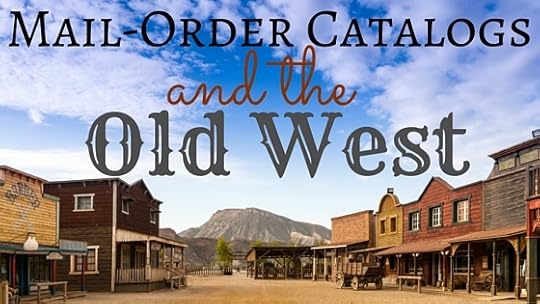
In my previous article, Paper: Common in the Old West?, I shared newspaper advertisements from the Old West era and listings in two Montgomery Ward & Co. Catalogues (No. 13 [1875] and No. 57 [1895]). I couldn’t help my curiosity about how a person went about ordering something from Montgomery Ward or Sears, Roebuck & Co., Bloomingdales, or the like… and decided to do a little digging.
I own paperback unabridged facsimiles of the two aforementioned Montgomery Wards & Co. catalogues (their choice of spelling), and the Sears, Roebuck & Co. Consumer’s Guide for 1894. I’ve also purchased the Bloomingdale’s Illustrated 1886 Catalog (their choice of spelling).

Interesting Historical Tidbit:
Only in the late 19th century, with the movement in the U.S. to develop a uniquely American form of the language, did catalog begin to make a comeback. It was not one of the original American spellings, though; the word is listed as catalogue in all early editions of Noah Webster’s dictionary, which played a large role in conventionalizing many other uniquely American spellings. By the 1890s, however, instances of catalog are easily found in all sorts of American texts. [Source]
Aaron Montgomery Ward started the first giant mail-order enterprise in Chicago just after the great fire of 1871— in 1872. The Transcontinental Railway completed in 1869, so Ward was well-positioned to reach remote areas in the west as well as working families throughout the longer settled regions. Chicago is well-situated to address business throughout the continental United States.

Sears, Roebuck & Co. Consumer’s Guide 1894, pg 3: take pride in selling goods “Almost Everywhere!” Every city, every town, every hamlet in every state…and nearly every country on the globe.
Sears, Roebuck & Co. wasn’t alone in their pledge to meet the needs of the isolated farmer and rancher. Montgomery Ward & Co.’s “remarks” (page 1 of Catalogue and Buyer’s Guide No. 57, Spring and Summer 1895) states:
Our business was organized in 1872 to meet the wants of the Patrons of Husbandry, from whom we then received our main support. We did not, however, refuse the patronage of any person, knowing that the more good we handled the cheaper we could sell them.
Both companies took pride in selling directly to the consumer at prices well below those available at the country market (general mercantile). Shop owners bought in much lower quantities than the giant mail-order companies and needed to make a profit. Montgomery Ward & Co. went so far as to encourage relatively small groups of neighbors to band together, make group purchases called Club Orders, and split the discount awarded for paying in cash.
PLACING ORDERS
I find it interesting that most catalog companies instructed purchasers to simply send a letter with a distinct list of information: name, basic address, method of shipment (more later on), precise items requested, and total amount of money enclosed. Bloomingdale’s catalog gives nearly identical instructions as those pictured below (Sears).
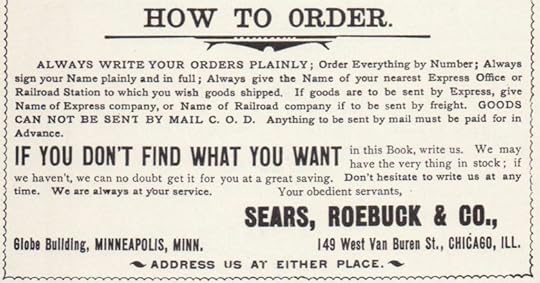
How to Order: Sears, Roebuck & Co., 1894, pg 4.
Montgomery Ward & Co. provided order slips with their catalogues and would send additional order forms by mail as requested. As an amateur historian, I’m stunned at the sheer quantity of business correspondence these catalogues suggest. Note the Sears image, above, wherein they state “Don’t hesitate to write us at any time. We are at your service,” and “If you don’t find what you want in this book, write us. We may have the very thing in stock.”

Sample Heading for Order. Montgomery Ward & Co., 1885 Catalogue, pg 2
HOW TO PAY
Note the Montgomery Ward order slip sample (that could just as easily be replicated in a person’s correspondence simply by providing the information as outlined)–center, right-hand side. “State here the amount of money sent and whether Draft, Express Money Order, Postal Order, Postal Note, Currency, or Stamps.
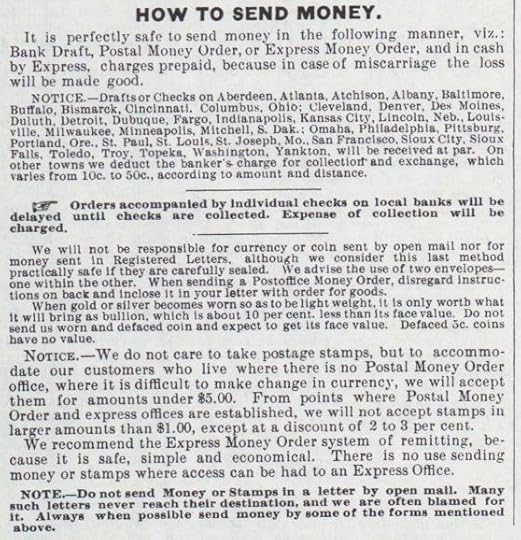
How to Send Money. Montgomery Ward & Co., 1885 Catalogue, pg 1
DELIVERY METHODS
Mail (United States Postal Service). Postage cost 1¢ per ounce (16¢ per pound) and was limited to 4 lbs. maximum per package (though an unlimited quantity of 4 lb. parcels may be delivered to any one address). Cash payments required in full prior to shipment, to cover goods and postage.
Express Service (Agents at the Rail Depot) — made allowances for C.O.D. and the ability to examine the product prior to paying for it. Payment could be made directly to the agent. This necessitated the purchaser live in or near the railway town with easy access to the express office. Express orders should exceed $5.
Railway Freight (if more than 100 lbs. in weight). This would work ideally for a “club” order (group of neighbors placing an order together), or when ordering a piano or other large object.

Richard Sears recognized customers of the day felt it was risky to order and pay for merchandise before it had been examined [preface of Sears, Roebuck & Co. 1894]. As an insurance of the company’s integrity, Sears established the now-famous policy of “Satisfaction Guaranteed or Your Money Back”. Sears excelled in this arena by offering C.O.D., subject to examination, with minimal money sent in as a guarantee of good faith.
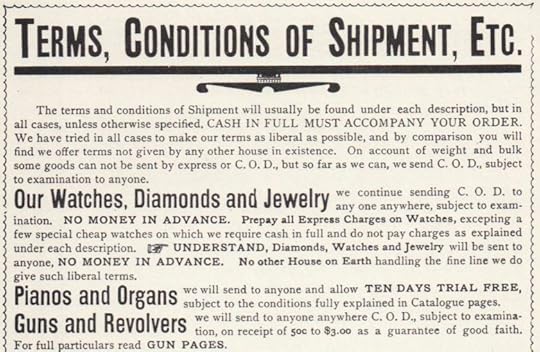
Sears, Roebuck & Co., 1894, pg. 4, Part 1
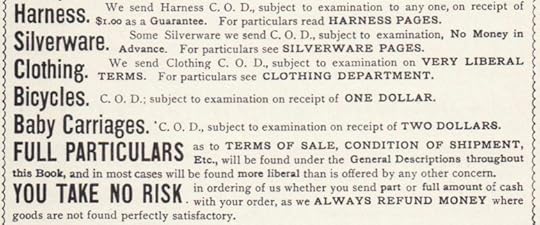
Sears, Roebuck & co. 1894, pg 4, part 2

 One more interesting historical tidbit. Browsing through these catalogues, the old prices seem ridiculously low (even with inflation). One and two dollars for “earnest money” seems too low to be meaningful. Amateur historians may find this Inflation Calculator immensely helpful.
One more interesting historical tidbit. Browsing through these catalogues, the old prices seem ridiculously low (even with inflation). One and two dollars for “earnest money” seems too low to be meaningful. Amateur historians may find this Inflation Calculator immensely helpful.
To put the $2.00 (in 1894 [Sears’s Catalogue year]) in earnest money to examine a baby carriage = $55.56 in 2015 (this particular online calculator doesn’t offer 2016 as an option). BTW, baby carriages ranged in price from $2.68 [$74.44] to $23.60 [$655.56] (about 16 options). Baby buggies were apparently not for the poor.
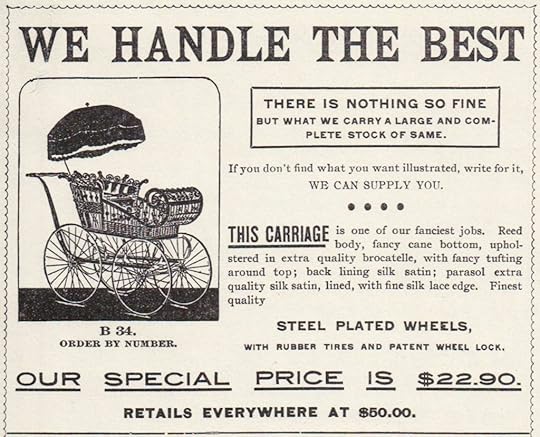
Baby Carriage (one of approximately 16) offered in Sears, Roebuck & Co. Consumer’s Guide for 1894, p. 193. Adjusting for inflation, this “special” price of $22.90 is equivalent to $636.11 in the year 2015.
Please forward this article to someone you think would enjoy it! See the “envelope” icon on the social sharing panel at the top and bottom of this article page. Comments? I’d love to hear what you think of the subject of mail-order companies in the 19th Century American West.
Related Articles–Mail-Order Catalogues:
Related Article– Pencils: Common in the Old West? Related Article– Paper: Common in the Old West?
Up next: Mail-order catalogs didn’t show up in America as early as you might think… and couldn’t have impacted the mail-order bride phenomenon as early as today’s popular fiction market makes it seem. Stay tuned for my upcoming article Mail-Order Catalogs: Timeline and Truth. After all, fans of the mail-order bridge niche will find these historical tidbits fascinating!
Copyright © 2016 Kristin Holt, LC
.
January 26, 2016
Paper: Common in the Old West?
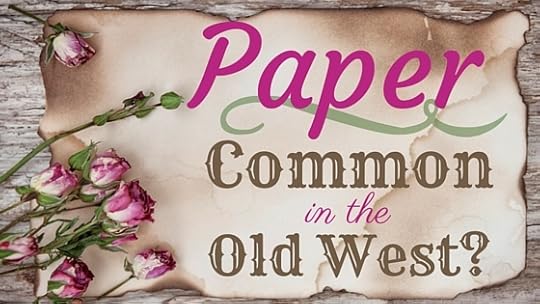
We’ve determined pencils (and pens) could indeed be classified as “common” in the Old West. But what about paper? I’ve read books where the intrepid hero has to reuse brown paper the mercantile owner used to wrap a purchase in order to leave the heroine an all-important note. I read another novel where a would-be bride’s employer deducted the cost of paper and envelope from her wages.
Was paper that expensive?
Did expense translate to scarcity?
Was paper common in the Old West?
An article published in the Lawrence Daily Journal newspaper on 28 March 1888 indicates slates (for students in public schools) had become a thing of the past, and reading a bit between the lines (“when we were boys”) suggests the slate had been passé, perhaps for a generation.
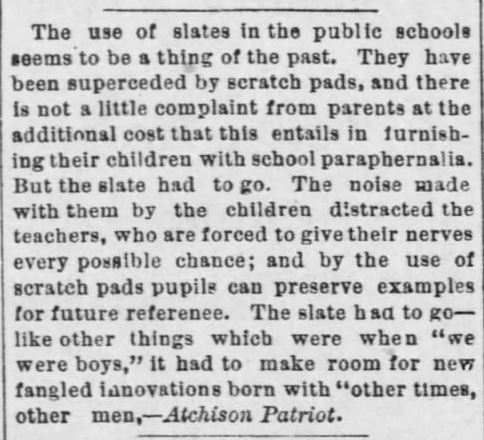
Image courtesy of newspapers.com
This newspaper article references scratch pads, a term still common today. The product listing, below, comes from the unabridged facsimile Montgomery Ward & Co. Catalogue & Buyer’s Guide (1895).
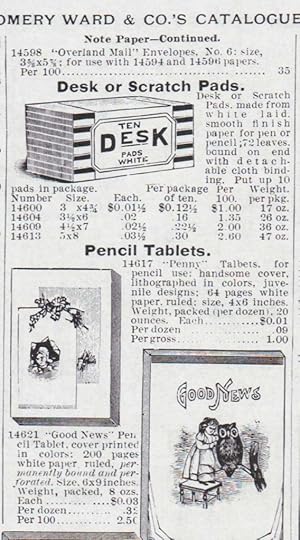
Note the highly reasonable price for 4 graduated sizes of scratch pads (not overly large, but for most purposes, highly functional). Seventy sheets of scratch paper (sewn together into a pad/tablet) in the largest (5×8-inch) size cost a whopping 3.5 cents, and a package of ten such tablets cost a discounted 30 cents. Granted, inflation has affected pricing quite a bit. But keep in mind the prices of pencils at the same time period (roughly 2 to 13 cents each). For the price of an inexpensive every-day pencil, a body could purchase a pad of paper (at least from a mail-order catalogue).
The Stationery Department (including envelopes, note cards, paper tablets, single sheet papers, special correspondence notes, fine stationery, tinted linen note paper, blotting papers, fancy boxes to hold stationery products) runs more than 3 pages (approximately 9.5 x 12-inches)… and that’s before the company gets around to offering writing utensils. The following two images show a few more of their many options.
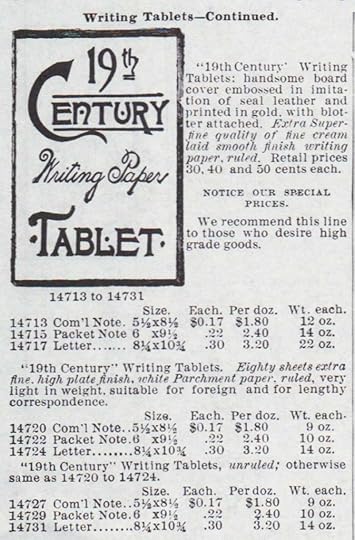
19th Century Writing Paper Tablet as presented in the Montgomery Ward & Co. Catalogue (unabridged facsimile) & Buyer’s Guide, 1895, p. 112.

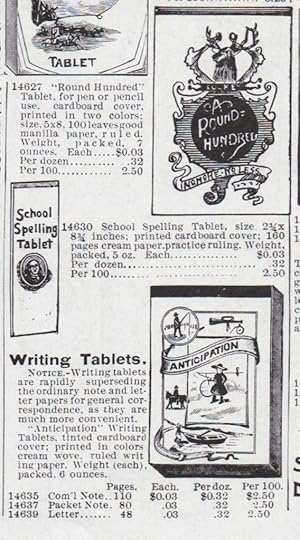
Additional options from the Montgomery Ward & Co. catalogue (1895), including a School Spelling Tablet, general Writing Tablets, and “manilla paper” for general use and correspondence. Pg. 111 of catalogue.
Twenty years earlier, in the Montgomery Ward & Co. Catalogue No. 13 (Spring and Summer, 1875), paper was a bit more expensive.
…and far fewer choices were offered by this company through the mail. The company had only been in business for about three years at that time (founded in Chicago in 1872).
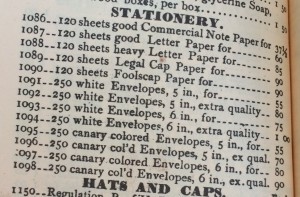
Montgomery Ward & Co., Catalogue No. 13 (1875), pg 32
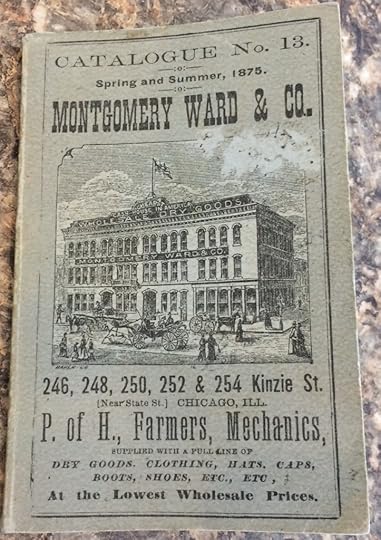
Montgomery Ward & Co. Catalogue No. 13, Spring and Summer 1875. Anniversary reproduction (unabridged facsimile) produced approx. 1975 by the Montgomery Ward company.
Most pages of this reproduction catalogue offer no pictures and no further information, so it’s hard to guess what dimensions of the first listing, item #1086, “good Commercial Note Paper”. At 37 and 1/3 cents for 120 sheets, even if this “good” paper was roughly 8.5 x 11-inches (today’s standard), it proves significantly more expensive than the 1895 offering. But note the foolscap listing. Foolscap had been common and standard throughout the 18th century in the British Commonwealth, and was simply common paper cut to 8.5 x 13.5-inches. In this 1875 catalogue, 120 sheets of foolscap sold for 90 cents– evidently larger in dimensions than the Commercial Note Paper.
[Note: This 1875 reproduction (and supposedly the original) is TINY. It measures roughly 4×5-inches and less than 1/4-inch thick.]

Advertisement for paper supplies and pencils, from The Council Grove Republican Newspaper, 28 January 1898. Image: Courtesy of newspapers.com
Throughout the Old West period, people had more options than ordering through mail-order businesses. Local stores carried paper, pencils, pens, etc. Their prices, at least as reflected in these two newspaper advertisements (in the 1890’s), seem to be quite competitive (though page count and size aren’t provided), though mail-order companies took pride in advertising the lowest prices possible (as they purchased in bulk and cut out the middle-man [shop owners]). Wichita and Council Grove weren’t necessarily remote locations, nor were they very far “west”, thus I imagine small country stores in out-of-the-way locations likely needed to (and could) charge more in order to cover freight and money invested in inventory.
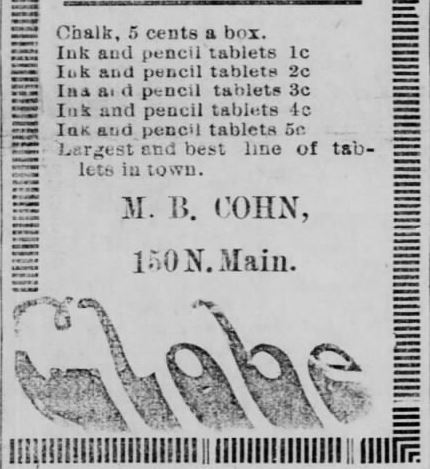
Advertisement for Tablets, Paper, Pencils, Chalk. Posted in the Wichita Beacon newspaper, Wichita, KS, on 15 October 1894. Image: Courtesy of newspapers.com.
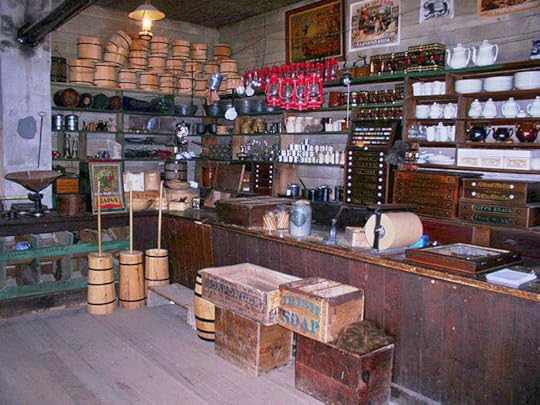
Note the roll of brown paper on the counter of Harkin’s 1870’s General Store. Purchases were wrapped in brown paper then tied with twine. Image: Shared in accordance to all Creative Commons License requirements. By McGhiever (Own work) [GFDL (http://www.gnu.org/copyleft/fdl.html) or CC BY-SA 3.0 (http://creativecommons.org/licenses/b...)], via Wikimedia Commons. https://upload.wikimedia.org/wikipedi.... https://commons.wikimedia.org/wiki/Fi....
Harkin’s Store, New Ulm, Minnesota
With prices such as these, is it any wonder frugal people saved the brown paper merchants used to wrap purchases and reused as much as possible? Along with many other products and manufacturing processes, paper-making’s boon came during the Industrial Revolution and wood pulp-based paper became affordable enough for everyone to buy and use (but probably not use wastefully). According to Wikipedia, new machines created in England were in use by at least one paper mill.
So, in short… yes. Paper was common (enough) in the Old West.
A cowboy might have pulled a used piece of foolscap out of his saddlebags to scribble a note in pencil (sharpened with his pocket knife), tear off the edge, and stake it to the trail… but a well-to-do Miss (say, a daughter of a mayor in a western town) would have had access to pretty stationery to write love letters to her beau.
A future article posted here (www.KristinHolt.com) will delve into the intricacies of how our great-great grandmothers ordered from the catalogue. After all, the process was so very different than today’s online shopping. Stay tuned! This article is coming next.
Related Article– Pencils: Common in the Old West? Related Article: Victorian Fountain Pens Related Article: The Victorian American West
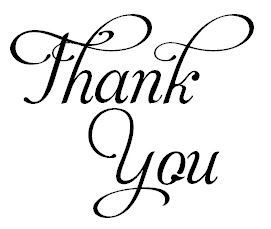
Please leave a comment, if you wish, and SHARE this article with a friend who’d find the content interesting. See the share buttons at the top and bottom of each Article (Post).
Used copies of Sears, Roebuck & Co. (1894) | Used copies Montgomery Ward & Co. (1895) | Listings for Montgomery Ward & Co. Catalogue No. 13 (Spring and Summer, 1895) on eBay
| Used copies Montgomery Ward & Co. (1895) | Listings for Montgomery Ward & Co. Catalogue No. 13 (Spring and Summer, 1895) on eBay
Copyright © 2016 Kristin Holt, LC
.
January 14, 2016
Pencils: Common in the Old West?
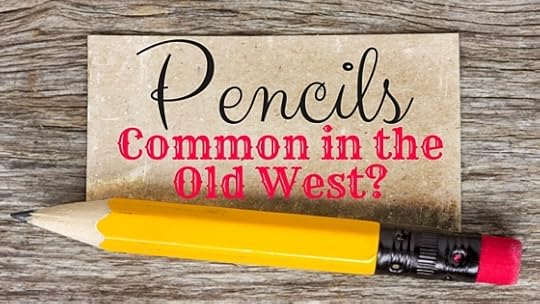
Pop Quiz:
You’re reading along in a cowboy Old-West Romance… 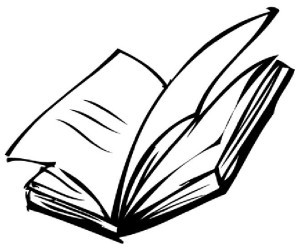 and somebody’s using a pencil to write in a journal, “pen” a letter, or make a notation in a ledger.
and somebody’s using a pencil to write in a journal, “pen” a letter, or make a notation in a ledger.
Is this historically possible?
Does it yank you out of your enjoyment to pause and wonder?
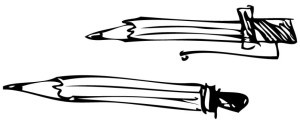
Were Pencils Common in the Old West?
Yes.
That doesn’t necessarily mean they were as plentiful as today, where my kitchen junk drawer holds roughly 7 thousand of them, and my the pen cup on my desk hosts another two dozen. But in the days of the Old West, pencils weren’t luxury items, either.
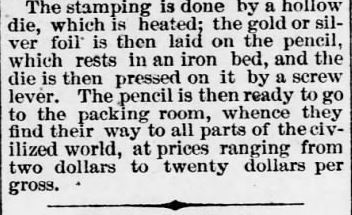
Closing paragraph of an article “How Pencils Are Made” published in The Wynadott Herald, Kansas City KS on Thursday 13 June, 1872. Image, courtesy Newspapers.com.
The Wynadott Herald of Kansas City, Kansas, published an article 13 June 1872 about how “commonplace” pencils are made, concluding with the price ranging from $2.00 per gross (A gross = 144 count) [One pencils costs less than two cents] to $20.00 per gross [one pencil costs less than fourteen cents].
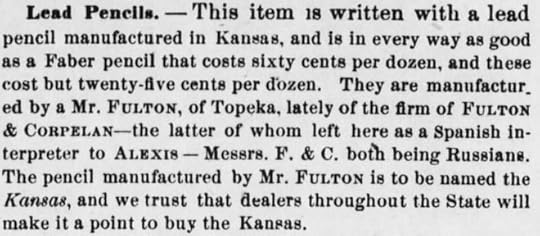
Newspaper clipping from Kansas Farmer, Topeka Kansas, Monday, 1 April 1872 edition. Image courtesy of newspapers.com
In many ways, pencils were much more portable than pen and ink. Prior to the invention and common usage of fountain pens, people literally had to have a separate bottle of ink to dip pen nubs in. Messy business, that.
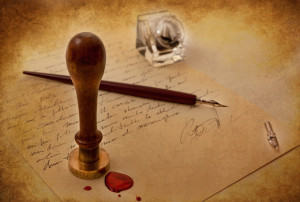
A significant, dense (the only of its kind, to date, in fact) natural repository of solid graphite was found at Cumbria in England in the 1500’s. Graphite is not lead, but chemists at the time didn’t know that. Hence the term “lead pencil”, though graphite is a form of carbon and not related. Believe it or not, people did contract lead poisoning from graphite pencils…but not because of the core. Paint used in the 19th century contained lead and those prone to chewing their pencils would ingest the lead paint, causing lead poisoning.
Colonial Americans imported pencils from England (and Germany via England), though eventually turned their inventive natures on the need for locally produced goods. “William Munroe, a cabinetmaker in Concord, Massachusetts, made the first American wood pencils in 1812. This was not the only pencil-making occurring in Concord. Henry David Thoreau discovered how to make a good pencil out of inferior graphite using clay as the binder; this invention was prompted by his father’s pencil factory in Concord, which employed graphite found in New Hampshire in 1821.” [Source]
Factories harnessed the industrial revolution machination and quickly turned the time-exhaustive work of pencil-making into a mass-production enterprise. Early and significant pencil makers in the young United States were Joseph Dixon (Dixon Ticonderoga Co.) and John Eberhard Faber (Eberhard Faber Co.).
Any guesses when erasers were first attached to pencil ends?
Come on. Guess.
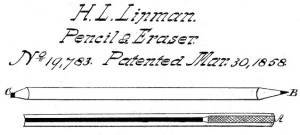
Hymen Lipman Pencil Eraser Patent, 1858. Image: Public Domain
1858. That’s early.
In the 1860’s and 1870’s, pencils were mass-produced in the United States, driving prices down and increasing the abundance.
“The demand for pencils seems to have been growing at an unprecedented rate at the time, and in the early 1870s it was estimated that over 20 million pencils were being consumed in the United States each year.” [Source]
The first mass-produced pencils were natural and unpainted–all the better to show off the high-quality wood casings (and make it obvious premiere red cedar was used). By this time, manufacturers started imprinting brand names on pencils. One major, determined-to-be-the-best manufacturer began painting their pencils their trademark bold yellow, thus informing consumers of superior quality at first glance. It wasn’t long and imitators also painted their pencils yellow.
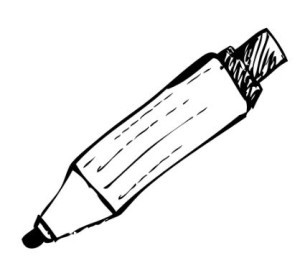
Mechanical Pencils were a 20th Century development, though, right?
“A mechanical (or “propelling”) pencil was patented by Sampson Mordan and John Isaac Hawkins in Britain in 1822. For a history and superb pictures of early mechanical pencils, see Deborah Crosby, Victorian Pencils: Tools to Jewels, Schiffer Publishing Ltd., Atglen, PA, 1998. Crosby (1998, p. 62) states that “Huge numbers of patents were issued for a variety of advancements or improvements in propelling pencils during the nineteenth century (between 1820 and 1873, more than 160 patents were listed pertaining to mechanical pencils).” In the U.S., patents for mechanical pencils predate the earliest patents for wood-cased lead pencils or pencil sharpeners.” [Source]
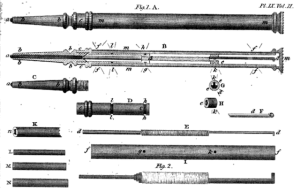
Detail of the specification of the patent granted in December 1822 to Sampson Mordan and John Hawkins, for improvements on pencil-holders. The first patent for a refillable pencil with lead-propelling mechanism was issued to Sampson Mordan and John Isaac hawkins in Britain in 1822. Image: Public Domain
And there you have it. Probably much more about the history of pencils and the probability that the literate in the Old West with simplest of means would have owned a pencil (or five), and likely used them regularly for all the reasons you and I do. Grocery lists. Letters (OK–maybe you don’t hand write letters anymore, and certainly wouldn’t in pencil if you did). Instructions. Addresses. Notes. Recipes.
If paper was had. But that’s a different topic.
Please, do leave a note. What do you think of this subject?
Copyright © Kristin Holt, LC 2016
.
January 9, 2016
Luxury Travel 1890-Style
While writing my two contributions to the American Mail-Order Brides Series, I researched many subjects of the year 1890.
Have I mentioned the research is often the FUN part for me?

Note: As of TODAY, you’ll find ALL FIFTY titles within the American Mail-Order Brides Series available on Amazon!

Lessie and Josie traveled from Massachusetts to Utah Territory to meet the men who advertised for two family-connected brides and paid their travel expenses. Both ladies traveled by standard Pullman Sleeper Car on the Overland Flyer (for the last leg from Omaha, NE; see images and content, below) to meet their grooms in The Junction of the West, Ogden City (often referred to as Junction City).
But Josie’s experience with train travel had just begun. The first half of her story is spent aboard the Cannon family Private Rail Car.

“In the late 19th century Gilded Age, wealthy individuals had finely appointed private cars custom-built to their specifications. Additionally many cars built by Pullman, Budd, and other companies that were originally used in common carrier service as passenger cars were later converted to business and private cars. There are various configurations, but the cars generally have an observation platform, a full kitchen, dining room, state room, an observation room, and often servant’s quarters.” [Source]
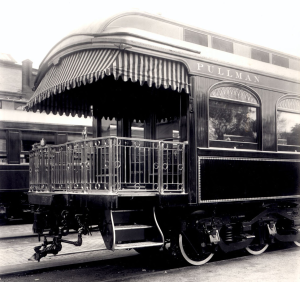
Observation Deck of Pullman Car
Naturally, Cannon Mining (my fictitious creation for Lessie and Josie), peers of Carnegie and Stanford, would have traveled by the same extravagant means. If you’ve read both Lessie and Josie, you’ll know Josie had the shock (and pleasure) of enjoying the private rail car’s amenities but Lessie never stepped on board.
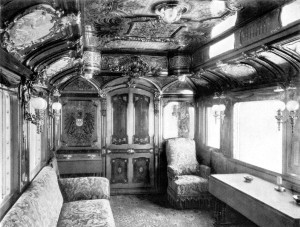
Salon No. 1 of Emperor Wilhelm II, 1890’s. Image: Public Domain. Apparently created 1890.
Privately owned rail cars such as these were truly private. The Emperor Wilhelm II had multiple cars, so his were strung together with vestibules between his many cars and pulled by a private locomotive. The first private railroad car was that provided by P. T. Barnum for the soprano Jenny Lind during her 1850-1852 American tour. Her rail car was singular and all-inclusive.
Railroad barons including Leland Stanford had private cars.
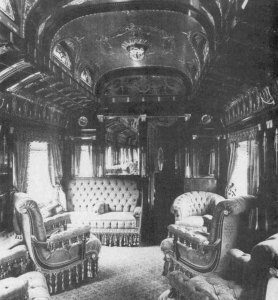
Private Rail Car Salon. Image: Public Domain
Various monarchies often had private locomotives and every car on the train was private and for exclusive use of the crown. In the United States, most private cars would be attached to a commercial train and paid arrangements made to navigate the lumber baron, steel mogul, mining millionaire (you get the picture) to wherever he determined to go.
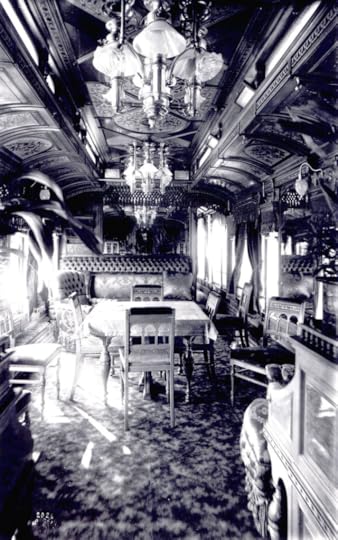
Private Car image of private dining room. Image: Public Domain.
While vestibules connected the public areas of the train (beginning in 1887), making it easy for passengers to move from one car to the next (from their seat to the dining car, for example), the private cars ran near the back where they could truly be private– without strangers traipsing through on their way to the dining room. This principle became a huge issue in Josie: Bride of New Mexico when Adam Taylor detected trouble and desperately alerted all passengers he had any access to– his own in-car staff.

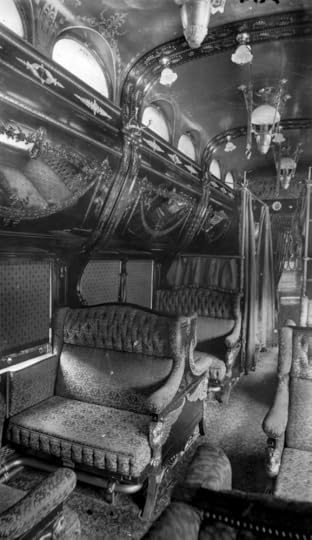
Pullman Sleeper Car. Upholstered Seats folded down into a bed much like today’s R.V. Trailers. The rounded overhead “bin” came down revealing another bed. Curtains provided privacy. Image: Public Domain
Not all train passengers (from 1887 through turn of the century [1899-1900]) traveled in such luxury. Private rail cars were immensely expensive and accessible only by the most wealthy. The well-to-do could afford to travel by rail, and many did so in comfort after George Pullman traveled by train and found himself most uncomfortable. He set about to improve the railway experience for the common traveler (middle class and up). He designed and manufactured Pullman Sleeper Cars (with washrooms at either mend for men and for women) and the Pullman Dining Cars.
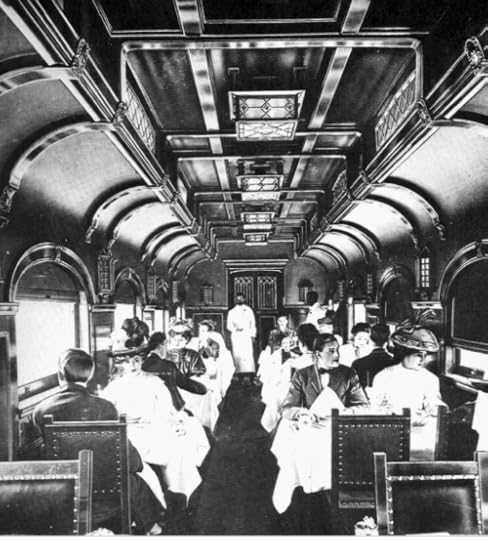
Pullman Dining Car. Passengers traveling in Sleeper Cars walked through the vestibule passageways from car to car to dine. Image: Public Domain

Series Description American Mail-Order Brides Series Facebook Page LESSIE: BRIDE OF UTAH book description page JOSIE: BRIDE OF NEW MEXICO book description page
Browse the American Mail-Order Brides Series for sale on Amazon

Note: Readers will find the entire American Mail-Order Bride Series available as FREE Reads with Kindle Unlimited— but this is only guaranteed for the first three months of each book’s individual life. The first title published on November 19, 2015. By mid-February 2016, it is possible some titles will begin to lose Kindle Unlimited status.
.
Copyright © 2016 Kristin Holt, LC
.
December 31, 2015
A Victorian Menu for New Year’s Day, 1892
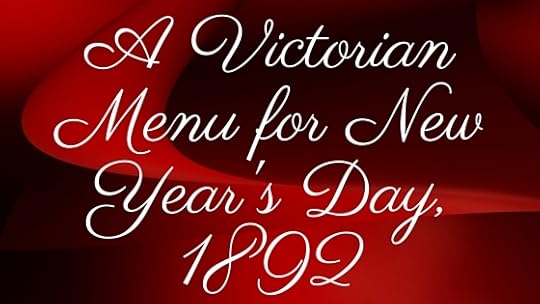
HAPPY NEW YEAR, 2016!
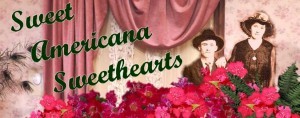
I blog once a month at Sweet Americana Sweethearts (first Friday of each month). Today’s article focuses on the American Victorian-Era New Year’s Day Celebrations. In that blog article, I show this menu posted in 1892 in a Pittsburgh, PA newspaper, but not the instructions— which those of us who are amused by history and cooking and the way things once were may well find fascinating. So this article is all about that menu… and how the home cook may have accomplished such a daunting task to celebrate the FIRST big holiday of the year.
.

This menu for New Year’s was posted in the Pittsburg [sic] Dispatch, Pittsburgh, PA, December 25, 1892:

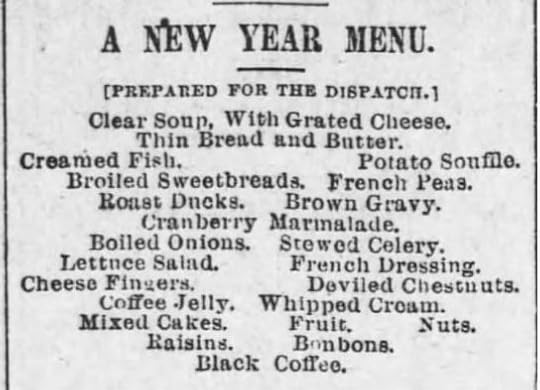
Note: please pardon the breaks in the newspaper columns copy, below. The reading was often interrupted with literal breaks… either from the bottom of a column to the top of the next, or an advertisement situated in the middle, etc. The discoloration, variation in clarity, light/dark areas, and out-of-focus bits are original to the microfiche/microfilm/scanned images I viewed online.
Honestly, can you imagine reading the paper… instead of grabbing a new recipe and instructions on a recipe or cooking website (and viewing on the ease and convenience of an iPad)?
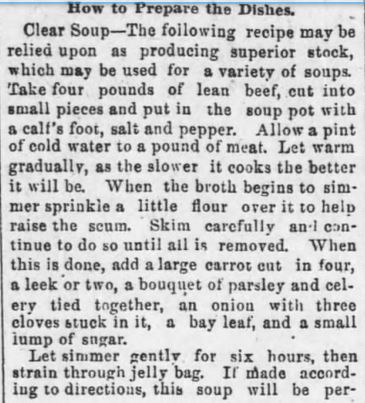
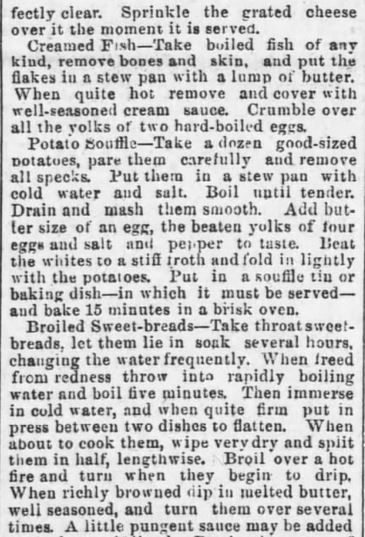
About now, I’m wondering if the author prepared a timeline… a list of instructions allowing me to see what to do when, and how to keep things warm should a side-dish be ready before it’s time to sit up to the table. Who has any idea how to figure out what to do first? When to pause and pick up the next task?
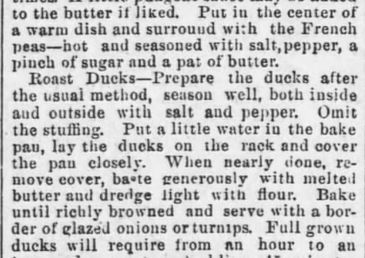
BTW: Any idea what “the usual method” might be when roasting ducks? See the first phrase after “Roast Ducks”– above.
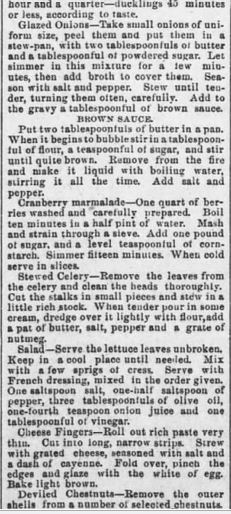

Did you know boxed (plain, unflavored) gelatin (spelled ‘gelatine’ in context) was available (and familiar) in 1892? Now we know!
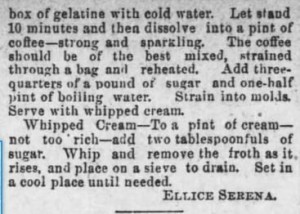

Are you as tired as I am, just from reading the instructions from Mrs. Ellice Serena? Of all the things I’m grateful for this New Year’s Day, the convenience and ease of cooking in my truly modern kitchen is one of them.
By the way, I’ve had a kick out of my two newest heroes (Adam in Josie: Bride of New Mexico, and Richard in Lessie: Bride of Utah) focused on modern conveniences… in their own world in 1890.
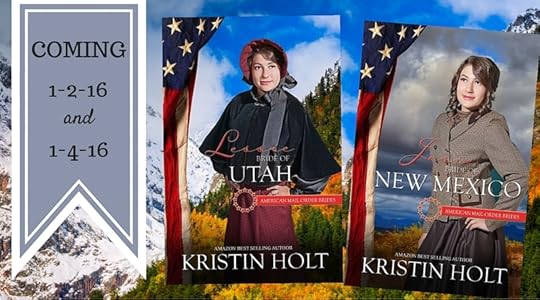
Tip: Lessie: Bride of Utah makes her debut tomorrow (technically, tonight near midnight). I hope you’ll consider spending a few hours with me and reading the first of my twin-sister mail-order-bride books in the American Mail-Order Brides Series by 45 authors (who wrote a total of 50 boos). I’m author of books #45 and #47. They release Saturday (1-2-16) and Monday (1-4-16), and with all 50 books in the series, for at least the first 3 months of publication, they’re available exclusively on Amazon.com.

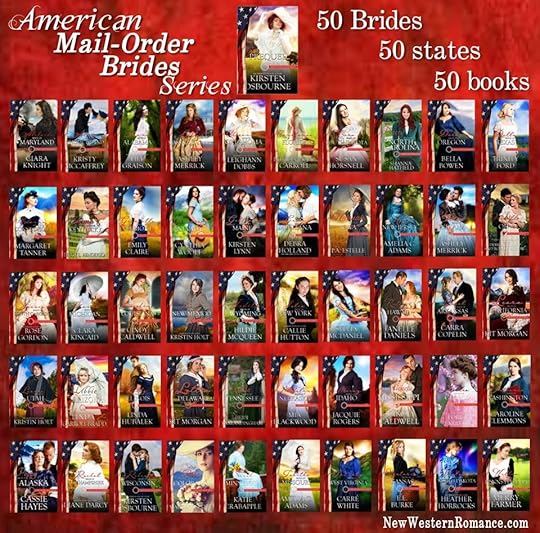

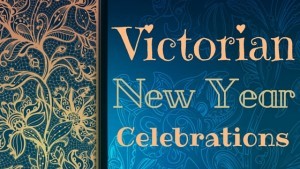
Now that you’ve had a chance to explore a suggested menu for New Year’s, please visit my post: New Year Celebrations in the American Victorian Era at Sweet Americana Sweethearts. After all, New Year’s Day for our great-great grandparents was so much more than just a sit-down meal at home. Come see courting traditions, paying calls, etiquette for such occasions, and a true-to-life Chicago restaurant menu for the holiday.
Related Articles:
Victorian New Year Celebrations: Kristin’s Post on Sweet Americana Sweethearts American Victorian Era Christmas Celebrations Victorian Era Thanksgiving Celebrations
Copyright © 2015-2016 Kristin Holt, LC
.
December 19, 2015
American Victorian Era Christmas Celebrations
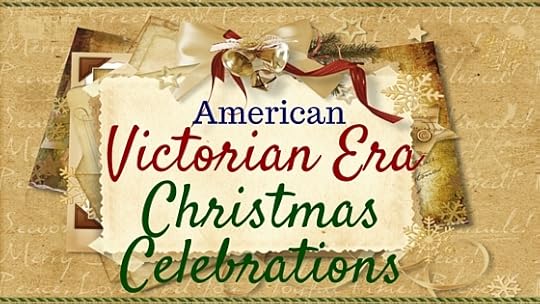
In the very early years of the United States’ history, Christmas celebrations remained highly localized and dependent upon the traditions of the settlers’ homelands. But by 1876 (The Centennial), what we consider a “Traditional Christmas” had become firmly formed. Contemporary Americans will recognize almost all of the Victorian traditions surrounding the holiday.
SHOPPING
“…typical way Christmas might have been celebrated by a family in New York City in 1876:
The Christmas season started early. The holiday shopping alone took a long time. Most people were members of large families, and there were a great many gifts to get. The city was filled with specialty shops where one could go just to buy English linen or French lace. In addition, the first of the large city department stores had appeared with their huge selection of goods. As always, shopping for children was the most fun. German mechanical toys appeared in great variety on the shelves. These clockwork devices, complete with moving parts, were particularly prized by boys and girls alike.”
~ Christmas in Colonial and Early America, from World Book
SOCIAL SEASON
By the 1860’s, ice skating parties at Christmastime had become all the rage. Ice skating had become popular as a family outing but also for courting couples, as it was a fun activity that could be accomplished under the watchful eyes of the youthful couple’s parents. Speaking of ice skating and its merits for a courtship outing, one publication printed, “the privilege a gentleman enjoys of imparting instruction in the art to his fair companion is to enjoy a combination of duty and pleasure not often within reach, and no relation is more calculated to produce tender attachments than that of pupil and tutor under such circumstances.” (unknown publication, possibly The Brooklyn Daily Eagle, quoted [without citation] in Christmas in Colonial and Early America, from World Book)
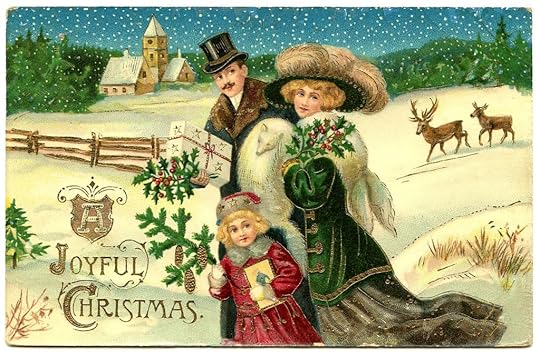
A Victorian-era Post Card. Note the cardboard showing at worn edges. Illustrates holiday visiting, gift-giving, church services, family togetherness, holly and evergreen boughs.
TRIM THE TREE
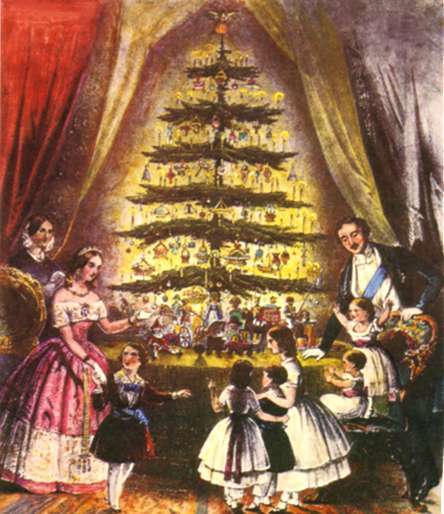
An engraving of the Royal Family— Queen Victoria and her husband, Prince Albert (German by birth)–celebrating Christmas at Windsor was published in 1848 and their German traditions were rapidly adopted throughout the U.K. and worldwide. If the Royal Family found something fashionable, the rest of the English-speaking world did, too.
“Queen Victoria’s mother was German as well, so the Royal Family did have trees before Prince Albert popularised the Christmas tree. Queen Charlotte, George III’s wife used to bring yew trees in at Christmas. But for most people in Britain the idea of having a tree inside was completely new. People would bring in a branch of a tree or holly or mistletoe, but there wasn’t that traditional Christmas scene that we know now.”
[source]
SANTA CLAUS
In the late 19th century, small children hung their stockings in gleeful anticipation of Santa Claus’s arrival during the night. Like the celebration of Christmas itself, Santa had not always been popular in all parts of America. Many concerned clergymen preached against Santa Claus from their pulpits because they feared that the emergence of such a folk culture here would draw people’s attention away from their celebration of Christ’s birth. but the idea of a jolly gift-giver from the North Pole proved to be so popular that he became a permanent part of every American Christmas celebration. ~Christmas in Colonial and Early America, from World Book
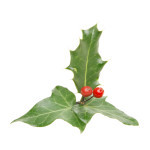
SENTIMENTS
TASTEFUL GIVING“It takes common sense and independence to accept a costly present from a rich friend, without making any return.
If you have money to spend on presents, do not waste on people richer than yourself, but on those poorer.
Above all, in sending presents do not send articles that cost money and are vulgar and tawdry. A piece of music, a note written on Christmas day, wishing many happy returns, or a few flowers, entail no obligation, require no work, and do their own work of love as well as costly gifts, and show a delicacy of breeding.”
The Ladies World, December 1892, quoted in This Fabulous Century 1870-1900 By the Editors of TIME-LIFE BOOKS.
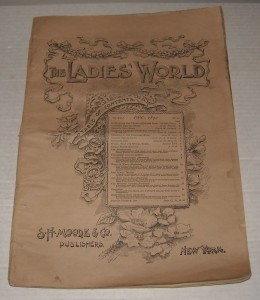
The Ladies’ World, December 1892. ** Current offer for sale on eBay: http://ebay.to/1S0EiYm **
For your convenience, see this edition of The Ladies’ World, currently offered for sale on eBay here.
In the same edition of The Ladies’ World (December 1892), is found:
“Would you have me steal to provide you with the mans of gratifying your desire to make expensive presents?” a young man only three years married asked his wife last Christmas. “I would have you support me in the manner to which I have been accustomed,” was the unwifely rejoinder. That night the young man went out. The next day he could not be found but later he was escorted to his home by his broken hearted father who found him in some out of the way place recovering from his first alcoholic spree. “This is your work,” the old man said to his daughter-in-law and never were words more deserved. It was her work that her husband cares no more for her; her work that she is unhappy; her work that her husband’s ambition is dead. It was impossible to satisfy her when he did his best; consequently further effort was useless. Reflect upon these things.”
The Ladies World, December 1892, quoted in This Fabulous Century 1870-1900 By the Editors of TIME-LIFE BOOKS.

Victorians were most fond of ‘morals’ within a story, with sentimental messages carried in magazine articles as well as popular fiction of the day. Charles Dickens’s A Christmas Carol was first published in 1843 in England, and quickly became an English-speaking world favorite. Many Victorian families made a tradition of reading this book aloud on Christmas Eve.
“No writer ever loved Christmas more than Dickens, and his tale of the redemption of Ebenezer Scrooge was felt, on both sides of the Atlantic, to be a perfect reflection of the spirit of the Victorian Christmas.”
~ Christmas in Colonial and Early America, from World Book
Storytelling of all kinds was a classic form of “Parlor Entertainment” (in the absence of TV, Blu-ray players, one-person video games, etc.). Interestingly enough, ghost stories were a premium form of entertainment (even for children) at the holidays. Dickens’ tale of the Ghosts of Christmas Past, Present, and Future was very much in keeping with the popularity of the day.

FEASTING
“Breakfast, at 8 o’clock Fruits, Breaded Chops, Tomato Sauce, Baked Potatoes, Buckwheat Cakes, Maple Syrup, Coffee.
Dinner at 2 o’clock Oysters on Half Shell, Almond Milk Soup with Rice, Salted Almonds, Celery, Olives, Halibut baked with fine Herbs, English Drawn Butter, Persian Potatoes, Roast Trukey, Cranberry Sauce, Rice Croquettes, Asparagus Tips, Braised Duck, Baked Macaroni, Lettuce Salad, Wafers, Brie, English Plum Pudding, Brandy Sauce, Coffee, Nuts, Fruits, Sugar Plums.
Supper, at 8 o’clock Raw Oysters, Chicken Sandwiches, Coffee, Jelly, Cake.”
—Table Talk, December 1890 (p. 459)

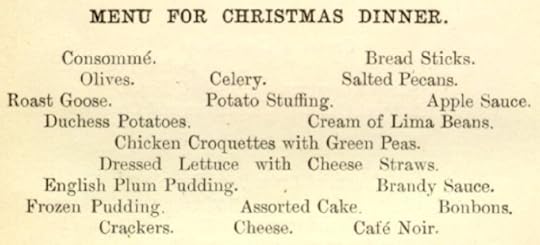
Menu for Christmas Dinner, The Boston Cooking-School Cookbook, By Fannie Merritt Farmer,
Boston, Little, Brown And Company (1896), page 520.

To Cook A Ham
“To Cook a Ham”: An excellent manner of cooking a ham is the following: Boil it three or four hours, according to size; then skin the whole and fit it for the table; then set in the oven for half an hour, cover it thickly with pounded rusk or bread-crumbs, and set back for half an hour longer. Boiled ham is always improved by setting it in an oven for nearly an hour, until much of the fat dries out, and it also makes it more tender.
The Practical Housekeeper, a Cyclopedia of Domestic Economy by Elizabeth Fries Ellet, 1857.

Related Article: Victorian Era Thanksgiving Celebrations
Copyright © 2015 Kristin Holt, LC
.
December 13, 2015
What Western Historical Readers Said About Kindle Unlimited WILL Surprise You…

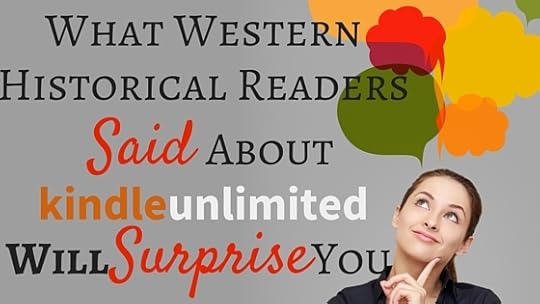

Right now, with 50 (yes, FIFTY) books in the American Brides Series releasing one book every single day, November 19th through January 7th, Pioneer Hearts Readers (and fans of Western Historical Romance) will have an absolute feast! And for some, it might break the bank.


That thought brought up the happy realization that with almost all (if not all) of these books available on Kindle Unlimited, subscribers to this service could literally read all 50 over the course of two calendar months for the price of two months’ subscription. That’s only $19.98 total, compared to $149.50 if a reader bought each and every title in the American Brides Series. Wow. A savings of $129.52.
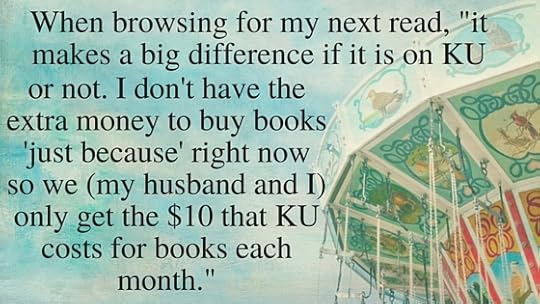
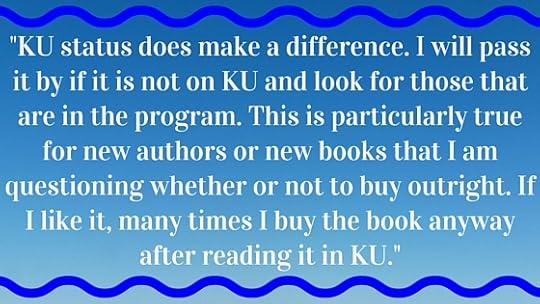

Kindle Unlimited, courtesy of Amazon’s page: http://amzn.to/1lFB3ZV
I’m the author of two of the fifty books: Lessie, Bride of Utah and Josie, Bride of New Mexico. It makes a whole lot of sense for me to want to read other books in this series. And read a lot of them. I hope to review many of my favorites for the benefit of other readers. An expensive proposition… but I’m a K.U. fan, so it’s a no-brainer for me. I’ll simply turn my K.U. subscription back on and reap the benefits.



Yet I realize not all readers share my preferences. Not everyone may have had a blue-skies-and-sunshine experience with K.U. Other readers might not love it as much as I do. Maybe they can’t find what they want to read within K.U. so the savings just isn’t there. Maybe they’re morally against subscriptions. Maybe it just doesn’t feel right.
I decided to go right to the source. I asked for volunteers to interview by email, and urged them to respond honestly. I won’t reveal the nine interviewee’s names, to further encourage honesty. Their feelings on the subject will surprise you.
.
Why am I so certain of the ‘surprise’ factor? Read on!
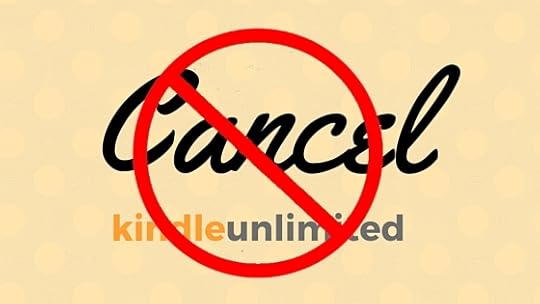
I interviewed ten subscribers to K.U. I was surprised to learn nine out of ten (granted, this is a small pool, but I’m still surprised) had remained loyal K.U. subscribers month after month after month without ever canceling, even for a brief period of time. I’m a reader, too, and I’ve subscribed and unsubscribed at least twice.
Seasons change. Demands on time fluctuate. I don’t always have time to read as much as I want to. To most of us, K.U. is a viable way to live within our budget for our favorite entertainment: books. $9.99/no can provide a great quantity of reading material. I was genuinely stunned by the loyalty during months when subscribers say they hadn’t borrowed a single book.
If I was surprised by this answer, I’m willing to bet you’ll be surprised by at least one insight shared.
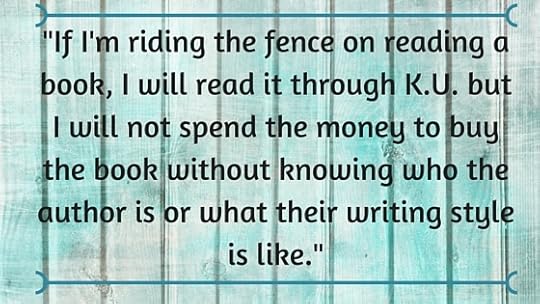
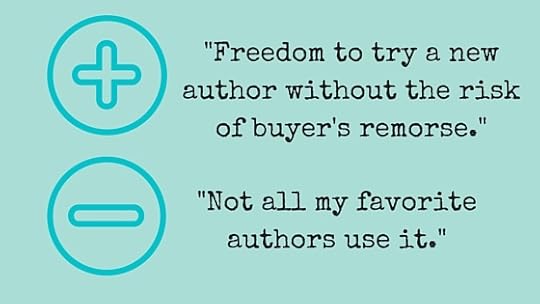
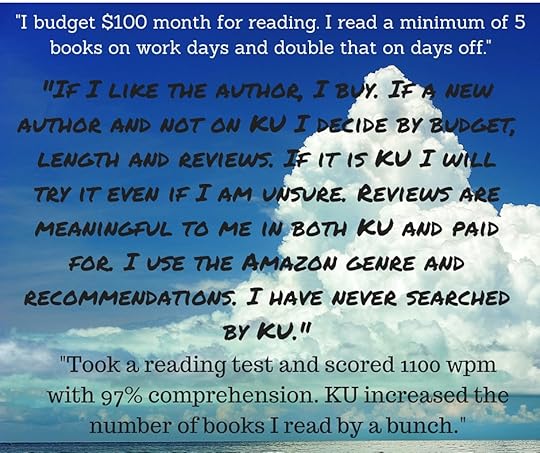
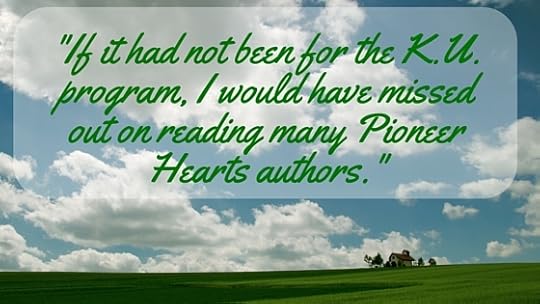

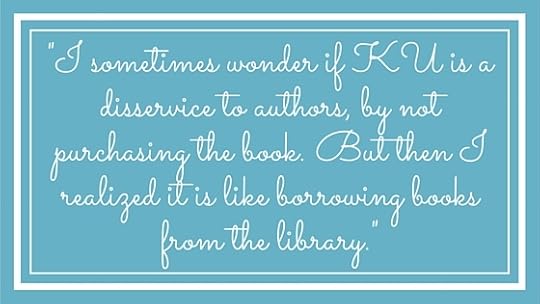

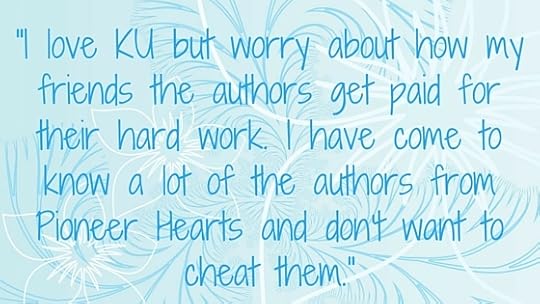
GOOD NEWS, dear Anonymous Pioneer Hearts Member and fan of so many… while individual authors’ opinions of how equitable payment for K.U. borrows are, my opinion is that it’s a very good thing for authors. My paycheck/royalties are HIGHER than they were pre-K.U. Authors are compensated for every page of every K.U. book borrowed.
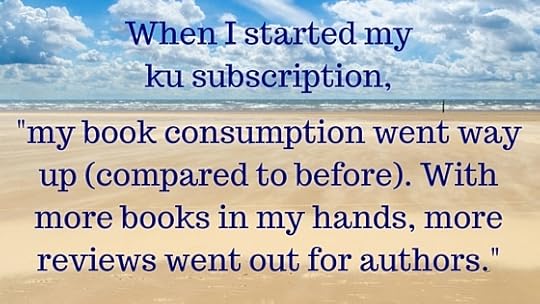
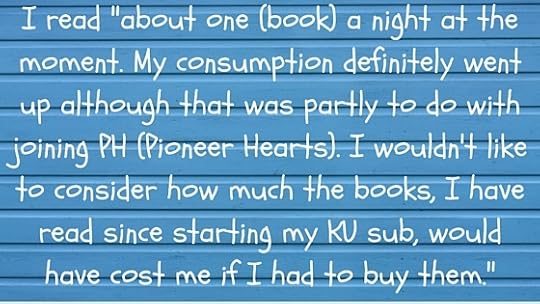

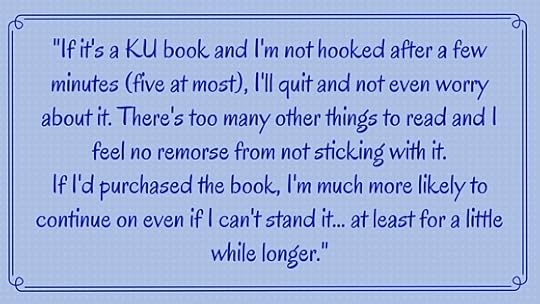


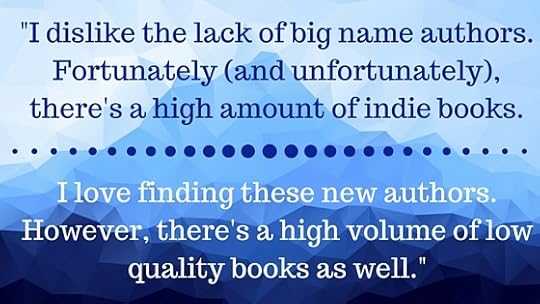
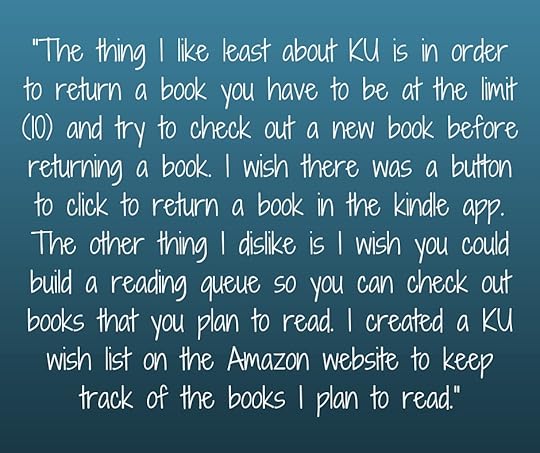
NOTE: Every quote contained within this blog article came directly from one of the ten K.U. Subscribers interviewed. Per my agreement with those interviewed, no names have been disclosed.
My sincere, heartfelt thanks to every individual who contacted me in response to my shout-out, seeking kindleunlimited subscribers (present or past) to interview. Your feedback made this article possible. Thank you!
.
Did any of the interviewee’s comments surprise you?
Is your opinion in line with any of these selected comments? How does your opinion differ?
Please take a moment and leave a comment.
.
RELATED POST: Give Unlimited Reading
Join the FUN on American Mail-Order Brides Series Facebook Page
Pioneer Hearts Book Store and Blog
Learn more about KU (Kindle Unlimited) on Amazon
.
So far, I believe 100% of the American Mail-Order Bride Series authors have selected kindleunlimited for their independently published titles. Exciting, yes? The links below represent only the first 20 out of 50, total. My two titles, Lessie: Bride of Utah (#45) and Josie: Bride of New Mexico (#47) will be released on January 2, 2016 and January 4, 2016. My two contributions to the series WILL be kindleunlimited (FREE) reads, or available at $2.99 for those who prefer to purchase.
Copyright © 2015 Kristin Holt, LC
.
December 10, 2015
SODA SPRINGS, Sweet Romantic Fiction by Carolyn Steele
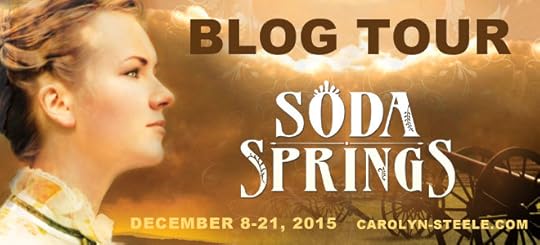
Soda Springs is a new release (12-8-15) by Carolyn Steele, author of Willow Springs. Published by Cedar Fort, Inc., this 264-page paperback is a clean, wholesome read and will appeal to readers of all ages. It is filled with accurate history ranging from Civil War-era North Carolina, wagon train treks across the continent toward Oregon, and the earliest white settlements in south-eastern Idaho.
I had the privilege of reading an Advance Review Copy (ARC) of Soda Springs and found the storytelling lyrical, enjoyable, and the characters multi-dimensional. I felt as though I’d spent several seasons in the company of Tessa Dare and her father, Mrs. Holt, and the others in the settlement near Soda Springs. The story is primarily Tessa’s, and it fits nicely into the book categories Coming of Age and Love Story.
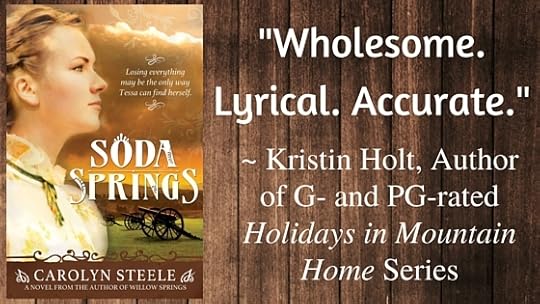
While Tessa is my main character, I fell in love with the backstories and character arcs of her father (Henry), Mrs. Holt, William, and the rest of the cast! Even then cantankerous Mr. Pixton surprised me at the end of the book.
.
I’m particularly proud of the historical accuracy of Soda Springs, right down to ensuring the language was accurate for the time frame. (I had to change the term “crush”–as in having a romantic fondness–because “crush” wasn’t used until in the following decade. And Shakespeare’s “paint the lily” didn’t become “gild the lily” until the turn of the century.) Even the Scottish phrases are accurate to the period.
.
~Carolyn Steele

Author Carolyn Steele
The book description on Amazon includes: “This sweeping story illuminates an oft-forgotten era in LDS Church history.” LDS is short for The Church of Jesus Christ of Latter-day Saints (sometimes referred to as the Mormons). Everyone with much understanding of initial white settlers in what has become the states of Idaho, Utah, and Nevada knows the LDS Church played a significant role. After all, it wasn’t a gold rush that first brought Anglo-Saxon Americans to the valley of the Great Salt Lake.
.
I want to emphasize my opinion (after an enjoyable read of this novel) that it will be enjoyed by people everywhere. This book not only for Latter-day Saints. Religion and religious connotations and references are superficial and play a minor role in the development of the story. Tessa is the only point-of-view character, and she is not a member of the LDS church when the book begins, nor nor is she one when the book ends (I hope that is not considered a spoiler). Tessa simply finds herself living among those who are… or used to be.

My father was still living when I began writing historical romance. He loved the draft of my first novel, Willow Springs, though he didn’t live long enough to see it published. In his final years, I loved sitting with him, reliving family vacations in Grays Lake, Idaho, his boyhood home. I began gathering information about Grays Lake to weave into a future novel. In my research, I stumbled upon the settlement story of Soda Springs, which is the gateway to Grays Lake, and knew this story had to be the backstory for my book. Soda Springs was settled in 1863 by a group of self-exiled Mormons called the Morrisites. The history of the Morrisites, their break from the LDS church, and subsequent exodus to southern Idaho is fascinating–and one I had never heard before.
.
In pondering what could cause a family not associated with the pioneer trek of the LDS church to make the arduous crossing on the Oregon Trail, my thoughts wandered back to my husband’s family roots in North Carolina. I love building intrigue into my writing, so what better than a conflict with roots in the Civil War?
.
~Carolyn Steele

.
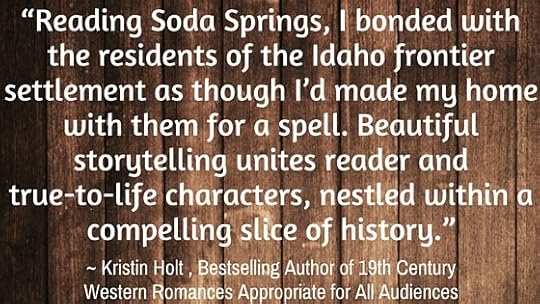
.
Copyright © 2015 Kristin Holt, LC
.
December 8, 2015
How to EASILY Write Helpful Book Reviews

If you’re thinking of the kind of Book Reviews your teacher in sixth grade made you write (and present)… forget all that. Let’s ignore the Scholarly Review component and focus on “Primary Source” reviews from readers to assist others in making purchases, finding new authors, and evaluate a book’s value from a consumer standpoint.

1. No need to write more than just a sentence or two—please don’t allow other readers’ long(er) reviews intimate you. Short is perfectly okay, though you can write a longer review if you want to. Often, less is more. One brief sentence, “I [insert: liked, loved, enjoyed] this book” will do. One more sentence explaining WHY is even more helpful.
2. BE HONEST. What matters most is YOUR opinion, YOUR feelings, YOUR inner critic and YOUR rating. This is YOUR review. It shouldn’t matter if other reviewers really loved a book– if you didn’t, say so. If other reviewers really hated a book and gave it low marks, don’t let it impact YOUR honest review.
3. What would have helped YOU as a buyer? (notes like “worth my time”, “enjoyed it”, “entertaining”, “I laughed”, “serious topic of ___”, “I liked it”, “I couldn’t put it down”, “I too easily put it down”, “I had a hard time finishing it”, “I wanted the characters to ____”, etc.) If you’re a “selective reader” (and search for Sweet/Clean books), did this book meet your expectations and standards? If yes, say so. If not, say so. Details inform other readers.
4. Not all book reviews are positive. Maybe elements of the author’s style disappointed you, or the story content was misrepresented in the book description. If you do leave a negative review, it’s helpful to other readers to understand WHY. Offer reasons.
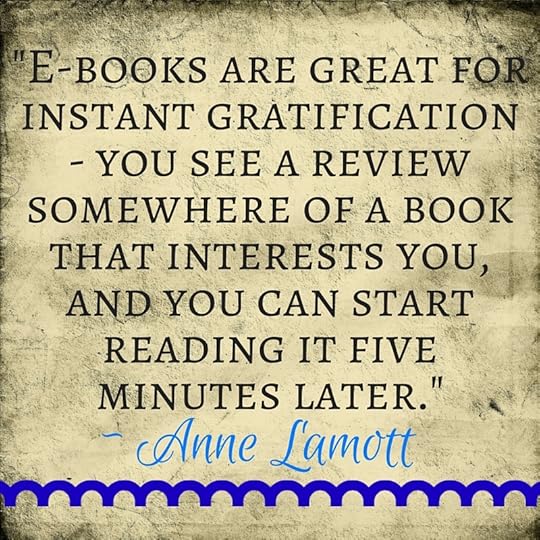
5. Avoid spoilers. (Spoiler = giving away story elements, plot twists, something the reader wouldn’t have known without reading… and now the fun of discovery is ‘ruined’ for them) If you absolutely must speak about a spoiler in a book review, be kind and flag it as a spoiler before you give the information away so readers might choose to stop reading your review at that point… or not.
6. Write a review the moment you finish reading, while the story is fresh in your mind… and you remember what you liked (or didn’t like) about it. Note: See Cassie’s quote, below; your review will do the MOST good if it’s more than just a stared rating… please write at least a few words to help other readers find books you truly enjoy. This may mean accessing the book’s page on Amazon, goodreads, Barnes & Noble, Kobo, or elsewhere. Readers and authors everywhere appreciate it!
7. Specifics help. Mention character names, setting places, story occurrences. Make it obvious the review is about the book specifically. Be Detailed. Be Accurate.
8. Who will enjoy this book? Is it for the young adult (YA) audience? Did the book appeal to the historian in you? Is it appropriate for readers of all ages (one of my biggest concerns within the Romance genre)? Will it interest those who enjoy mysteries?
9. In my opinion, fiction books are not all good nor all bad. Beneficial book reviews highlight both a favorite part and a least favorite part of the book.
.
I suggest reading Lesley Ann McDaniel‘s blog post (on goodreads), How to Write a Fiction Book Review. She offers excellent, simple specifics.

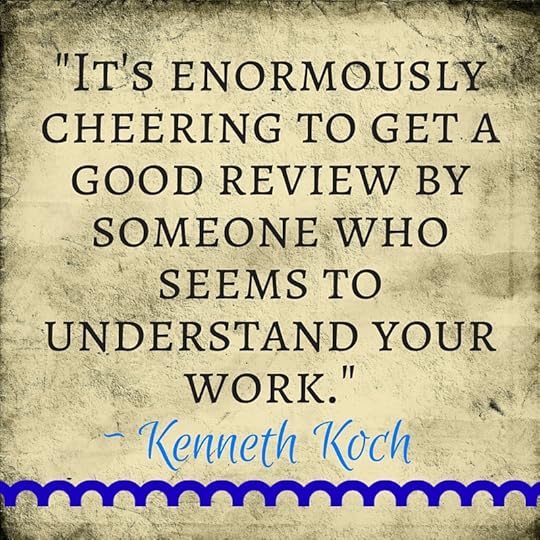

Related Article: Merry Christmas to my Favorite Author, including Writing Reviews of their Books
Many readers never stop to consider WHY book reviews are so helpful to readers AND to authors. Author Cassie Hayes sums it up beautifully:
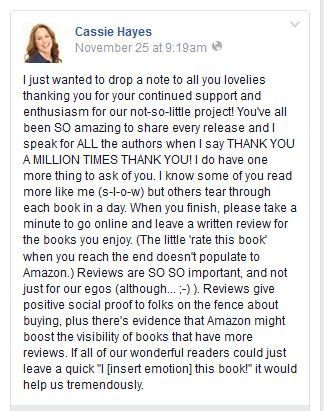
Cassie Hayes, author, posted on Facebook about the Importance and Value of Book Reviews, 11-25-15
BTW, she’s referencing the 50-book America’s Mail-Order Brides Series produced by 45 authors of western historical romance.
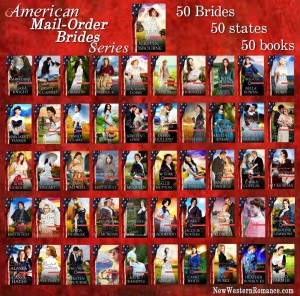

American Mail-Order Brides Facebook Page
Lessie: Bride of Utah (by Kristin Holt)
Josie: Bride of New Mexico (by Kristin Holt)
Copyright © 2015 Kristin Holt, LC
.
Kristin Holt's Blog
- Kristin Holt's profile
- 117 followers



